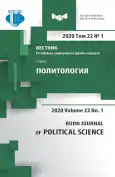Russia and China as Viewed by Russian and Chinese Youth
- Authors: Sorokina A.A.1, Maximenkova M.S.1
-
Affiliations:
- National Research University Higher School of Economics
- Issue: Vol 22, No 1 (2020)
- Pages: 144-160
- Section: CURRENT PROBLEMS OF POLITICAL SCIENCE
- URL: https://journal-vniispk.ru/2313-1438/article/view/322153
- DOI: https://doi.org/10.22363/2313-1438-2020-22-1-144-160
- ID: 322153
Cite item
Full Text
Abstract
Russia-China relations are a major research focus in international relations, yet few studies have so far addressed the issue of how the two nations view each other. This study seeks to contribute to closing this gap by focusing on how college-age millennials perceive the counterpart country. We have selected students who have had experience studying abroad, namely Chinese students who have studied in Russia and Russian students who have studied in China. Our findings are based on the analysis of 150 in-depth qualitative narrative interviews conducted with Chinese and Russian students (75 in each group). The study demonstrates that ethnocentric stereotypes prevail and both groups engage in cultural ‘othering’. Meanwhile, students from both countries perceive Russian President Vladimir Putin as a central determining factor in shaping Russia-China relations.
About the authors
Anna A. Sorokina
National Research University Higher School of Economics
Author for correspondence.
Email: aasorokina@hse.ru
Leading Research Fellow of Laboratory for Political Studies, Associate Professor
20 Myasnitskaya Str., Moscow 101000 RussiaMarina S. Maximenkova
National Research University Higher School of Economics
Email: mmaksimenkova@hse.ru
Director of Centre for Political Studies and Assessments in Institute for Applied Political Studies, lecturer
20 Myasnitskaya Str., Moscow 101000 RussiaReferences
- Rossiya - Kitaj - SSHA: otnosheniya v strategicheskom treugol'nike’. Russian Public Opinion Research Centre (WCIOM), (7 February 2017). Available from: https://wciom.ru/ index.php?id=236&uid=116055. Accessed 11.06.2018 (In Russ.).
- Noll J., Dekker H. A Comparative Analysis of Chinese urban Citizens’ attitudes towards the EU, the United States, Russia and Japan. International Relations. 2016; 30 (4): 456-472.
- Syed N.A. The Effect of Beijing 2008 on China’s Image in the United States: A Study of US Media and Polls. The International Journal of the History of Sport. 2010; 27 (16-18): 2863- 2892.
- Xie T., Page B.I. What Affects China’s National Image? A cross-national study of public opinion. Journal of Contemporary China. 2013; 22(83): 850-867.
- Fedorova K. Speaking With and About Chinese Language Attitudes, Ethnic Stereotypes and Discourse Strategies in Interethnic Communication on the Russian-Chinese Border. Civilisations. 2013; 62 (1-2): 71-89.
- Curanovic A. Why don’t Russians fear the Chinese? The Chinese factor in the selfidentification process of Russia. Nationalities Papers. 2012; 40 (2): 221-239.
- Dong L. Chinese Perceptions of the European Union. Journal of Contemporary China. 2014; 23 (88): 756-779.
- Ghazarian P.G. Country Image and the Study Abroad Destination Choice of Students from Mainland China. Journal of International Students. 2016; 6(3): 700-711.
- Katz D., Braly K. Racial stereotypes of one hundred college students. The Journal of Abnormal and Social Psychology. 1933; 28(3): 280-290.
- Bersick S. Perceptions of Asia in Europe. Asia Europe Journal. 2010; 8 (2): 244-255.
- Ng S.H., Ye J., Lee C. Media Discourse on Globalization in China: A Social-Psychological Analysis. Journal of Language and Social Psychology. 2011; 30 (2): 139-157.
- Zhang L. Stereotypes of Chinese by American college students: media use and perceived realism. International Journal of Communication. 2015; 9: 1-20.
- Blagojević G. Contemporary Serbian stereotypes about the Chinese in Belgrade: When you say China, I think about Block 70 or… Zbornik Matice srpske za drustvene nauke. 2009; 129: 47-6.
- Boden J. Mass media: Playground of stereotyping. International Communication Gazette: Formerly Gazette. 2016; 78 (1-2): 121-136.
- Li X., Worm V. Building China’s Soft Power for a Peaceful Rise. Journal of Chinese Political Science. 2011; 16 (1): 69-89.
- Hartig F. Confucius Institutes and the Rise of China. Journal of Chinese Political Science. 2012; 17 (1): 53-76.
- McKercher B. The Roots of Stereotypes about Tourists. Society. 2008; 45: 345-347.
- Nikitina L., Furuoka F. ‘Dragon, kung fu and Jackie Chan..’: stereotypes about China held by Malaysian students. Trames. A Journal of the Humanities and Social Sciences. 2013; 17 (2) (67/62): 175-195.
- Zhilina L. Public attitude and mutual perceptions: Japan and Russia. Political Science Journal. 2015; 10 (1-2): 1-30.
- Bukh A. Russia's Image and Soft Power Resources in Southeast Asia: Perceptions among Young Elites in Laos, Thailand and Vietnam. Contemporary Southeast Asia: A Journal Of International & Strategic Affairs. 2016; 38 (3): 445-475.
- Vasil'eva K., Ostrovskij A., Alagueva T. The Image of Russians in the Eyes of the Chinese and the Image of the Chinese in the Eyes of Russians on Contiguous Territory. Far Eastern Affairs. 2007; 35 (4): 104-114.
- Hsia T.A. Demons in Paradise: The Chinese Images of Russia. The Annals of the American Academy. 1963; 349: 27-37.
- Lukin A. Russia's Image of China and Russian-Chinese Relations. East Asia. 1999; 17 (1): 5-39.
- Bislev A. Student-to-Student Diplomacy: Chinese International Students as a Soft-Power Tool. Journal of Current Chinese Affairs. 2017; 2: 81-109
Supplementary files









